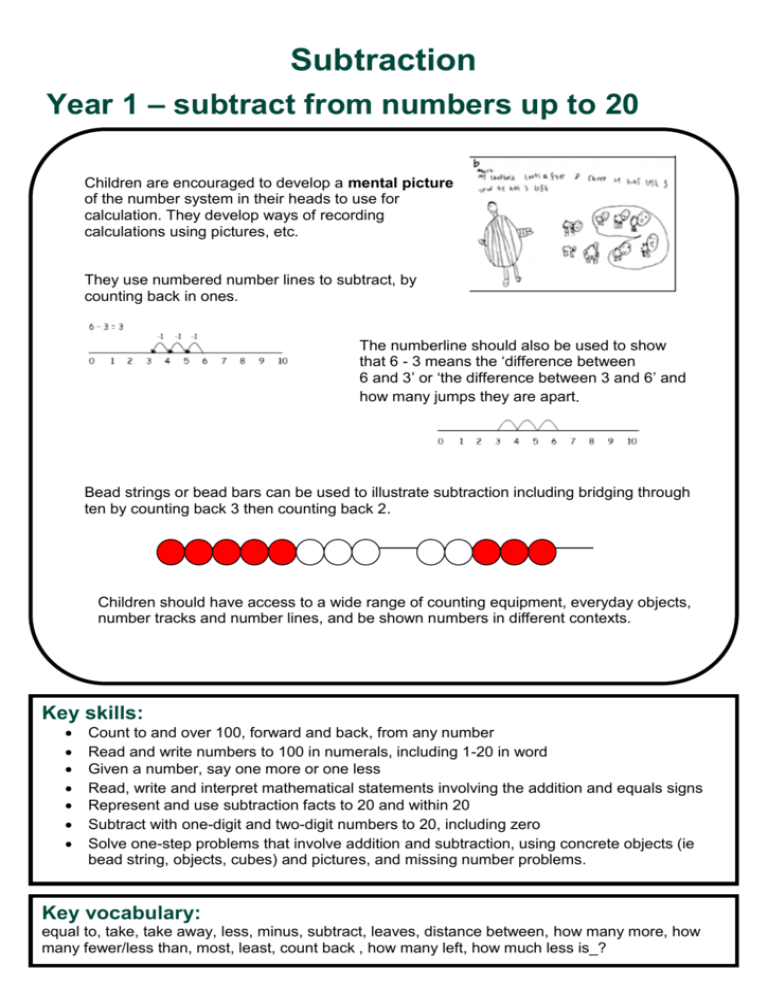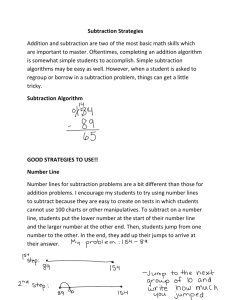Subtraction
advertisement

Subtraction Year 1 – subtract from numbers up to 20 Children are encouraged to develop a mental picture of the number system in their heads to use for calculation. They develop ways of recording calculations using pictures, etc. They use numbered number lines to subtract, by counting back in ones. The numberline should also be used to show that 6 - 3 means the ‘difference between 6 and 3’ or ‘the difference between 3 and 6’ and how many jumps they are apart. Bead strings or bead bars can be used to illustrate subtraction including bridging through ten by counting back 3 then counting back 2. Children should have access to a wide range of counting equipment, everyday objects, number tracks and number lines, and be shown numbers in different contexts. Key skills: Count to and over 100, forward and back, from any number Read and write numbers to 100 in numerals, including 1-20 in word Given a number, say one more or one less Read, write and interpret mathematical statements involving the addition and equals signs Represent and use subtraction facts to 20 and within 20 Subtract with one-digit and two-digit numbers to 20, including zero Solve one-step problems that involve addition and subtraction, using concrete objects (ie bead string, objects, cubes) and pictures, and missing number problems. Key vocabulary: equal to, take, take away, less, minus, subtract, leaves, distance between, how many more, how many fewer/less than, most, least, count back , how many left, how much less is_? Subtraction Year 2 – subtract with 2-digit numbers Children develop their mental fluency with subtraction and place value involving 2-digit numbers, then establish more formal methods as appropriate. Children will begin to use ‘empty number lines’ to support subtraction. First counting back in tens and ones: Followed by subtracting the tens in one jump and the units in one jump: Then becoming more efficient by subtracting the units in one jump (using the known fact 7 – 3 = 4): Bridging through ten can help children become more efficient: If the numbers involved in the calculation are close together or near to multiples of 10, 100 etc, it can be more efficient to count on. Key skills: Count in steps of 2, 3 and 5 and count in tens from any number Read and write numbers to at least 100 in numerals and in words Understand the place value of 2-digit numbers (tens and ones) Recall and use subtraction facts to 20 fluently, and derive and use related facts up to 100. Subtract a 2-digit number and ones (e.g. 27 - 6) Subtract a 2-digit number and tens (e.g. 40 - 23) Subtract using concrete objects, pictorial representations, 100 squares and mentally, including: a two-digit number and ones, a two-digit number and tens, and two two-digit numbers Know that subtraction of one number from another cannot be done in any order Recognise and use inverse relationship between addition and subtraction, using this to check calculations and missing number problems Solve simple addition and subtraction problems including measures, using concrete objects, pictorial representation, and also applying their increasing knowledge of mental and written methods. Key vocabulary: equal to, take, take away, less, minus, subtract, leaves, distance between, how many more, how many fewer/less than, most, least, count back , how many left, how much less is_?, difference, count on, strategy, partition, tens, units Subtraction Year 3 – subtract with 2- and 3-digit numbers Children will continue to use empty number lines with increasingly large numbers, and begin to use more formals written methods. Counting on should be reinforced as a useful method. The partitioned column subtraction method is introduced. The method is introduced for examples where exchanging is not required. Place value cards and Base 10 materials should be used to show the decomposition of the number: The concept of exchanging is introduced through the use of Base 10 or Numicon: This would be recorded by the children as: Key skills: Recognise place value of each digit in 3-digit numbers (hundreds, tens, ones) Read and write numbers to 1000 in numerals and words Find 10 or 100 more or less than a given number Subtract a 3-digit number and ones mentally Subtract a, 3-digit number and tens mentally Subtract a 3-digit number and hundreds mentally Estimate answers to calculations, using inverse to check answers Solve problems, including missing number problems, using number facts, place value, and more complex subtraction Use counting on as a mental strategy when numbers are close together or near multiples of 10 Practise mental subtraction strategies, such as subtracting near multiples of 10 and adjusting (e.g. subtracting 19 or 21), and select most appropriate methods to subtract, explaining why. Key vocabulary: equal to, take, take away, less, minus, subtract, leaves, distance between, how many more, how many fewer/less than, most, least, count back , how many left, how much less is_? difference, count on, strategy, partition, tens, units, exchange/steal, decrease, hundreds, value, digit, inverse, expanded, compact Subtraction Year 4 – subtract with 2-, 3- and 4-digit numbers Children will move from partitioned column subtraction to the compact column method. Using similar methods, children will: be able to subtract numbers with different numbers of digits; begin to find the difference between two three-digit sums of money, with or without ‘adjustment’ from the pence to the pounds; know that decimal points should line up under each other. NB Counting on using a numberline should still be used if the numbers are close together or near to multiples of 10, 100 etc. Key skills: Recognise the place value of each digit in a four-digit number. Round any number to the nearest 10, 100 or 1000. Find 1000 more or less than a given number. Count backwards through zero, including negative numbers. Subtract numbers with up to 4 digits using the formal written method of column subtraction Select most appropriate method: mental, jottings or written and explain why. Estimate and use inverse operations to check answers to a calculation. Solve 2-step problems in contexts, deciding which operations and methods to use and why Solve simple measure and money problems involving fractions and decimals to two decimal places. Solve number and practical problems that involve the above, with increasingly large positive numbers. Continue to practise a wide range of mental addition strategies including counting on where numbers are close together or they are near to multiples of 10, 100 etc. Key vocabulary: equal to, take, take away, less, minus, subtract, leaves, distance between, how many more, how many fewer/less than, most, least, count back , how many left, how much less is_? difference, count on, strategy, partition, tens, units, exchange/steal, decrease, hundreds, value, digit, inverse, expanded, compact Subtraction Year 5 – subtract with at least 4-digit numbers Children should extend the compact method to numbers with more than four digits. Using similar methods, children will: be able to subtract numbers with different numbers of digits; begin to find the difference between two decimal fractions with up to three digits and the same number of decimal places; know that decimal points should line up under each other. NB Counting on using a numberline should still be used if the numbers are close together or near to multiples of 10, 100 etc. Key skills: Read, write, order and compare numbers to at least 1,000,000 and determine the value of each digit Round any number up to 1,000,000 to the nearest 10, 100, 1000, 10,000 and 100,000 Count forwards or backwards in steps of powers of 10 for any given number up to 1 million Interpret negative numbers in context, counting forwards and backwards with positive and negative integers through zero Subtract numbers with more than 4 digits using the formal written method of column subtraction Subtract numbers mentally with increasingly large numbers, choosing and using a range of mental strategies Use rounding and estimation to check answers to calculations and determine, in a range of contexts, levels of accuracy Solve multi-step problems in contexts, deciding which operations and methods to use and why. Key vocabulary: equal to, take, take away, less, minus, subtract, leaves, distance between, how many more, how many fewer/less than, most, least, count back , how many left, how much less is_? difference, count on, strategy, partition, tens, units, exchange/steal, decrease, hundreds, value, digit, inverse, expanded, compact, tenths, hundredths, decimal point, decimal Subtraction Year 6 – subtract with numbers of increasing complexity Children should extend the compact method to numbers of increasing complexity. Using similar methods, children will: add several numbers with different numbers of digits; begin to add two or more decimal fractions with up to four digits and either one or two decimal places; know that decimal points should line up under each other, particularly when adding or subtracting mixed amounts, e.g. 401.2 + 26.85 + 0.71. NB Counting on using a numberline should still be used if the numbers are close together or near to multiples of 10, 100 etc. Key skills: Read, write, order and compare numbers up to 10,000,000 and determine the value of each digit Round any whole number to a required degree of accuracy Use negative numbers in context, and calculate intervals across zero Perform mental calculations, including with mixed operations and large numbers of increasing complexity, using and practising a range of mental strategies Solve multi-step problems in context, deciding which operations and methods to use and why Use estimation to check answers to calculations and determine, in the context of a problem, levels of accuracy Utilise and consider a range of mental subtraction strategies, jottings and written methods before choosing how to calculate. Key vocabulary: equal to, take, take away, less, minus, subtract, leaves, distance between, how many more, how many fewer/less than, most, least, count back , how many left, how much less is_? difference, count on, strategy, partition, tens, units, exchange/steal, decrease, hundreds, value, digit, inverse, expanded, compact, tenths, hundredths, decimal point, decimal



